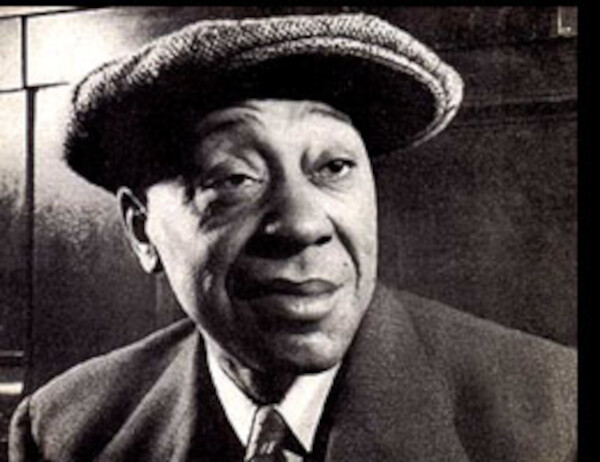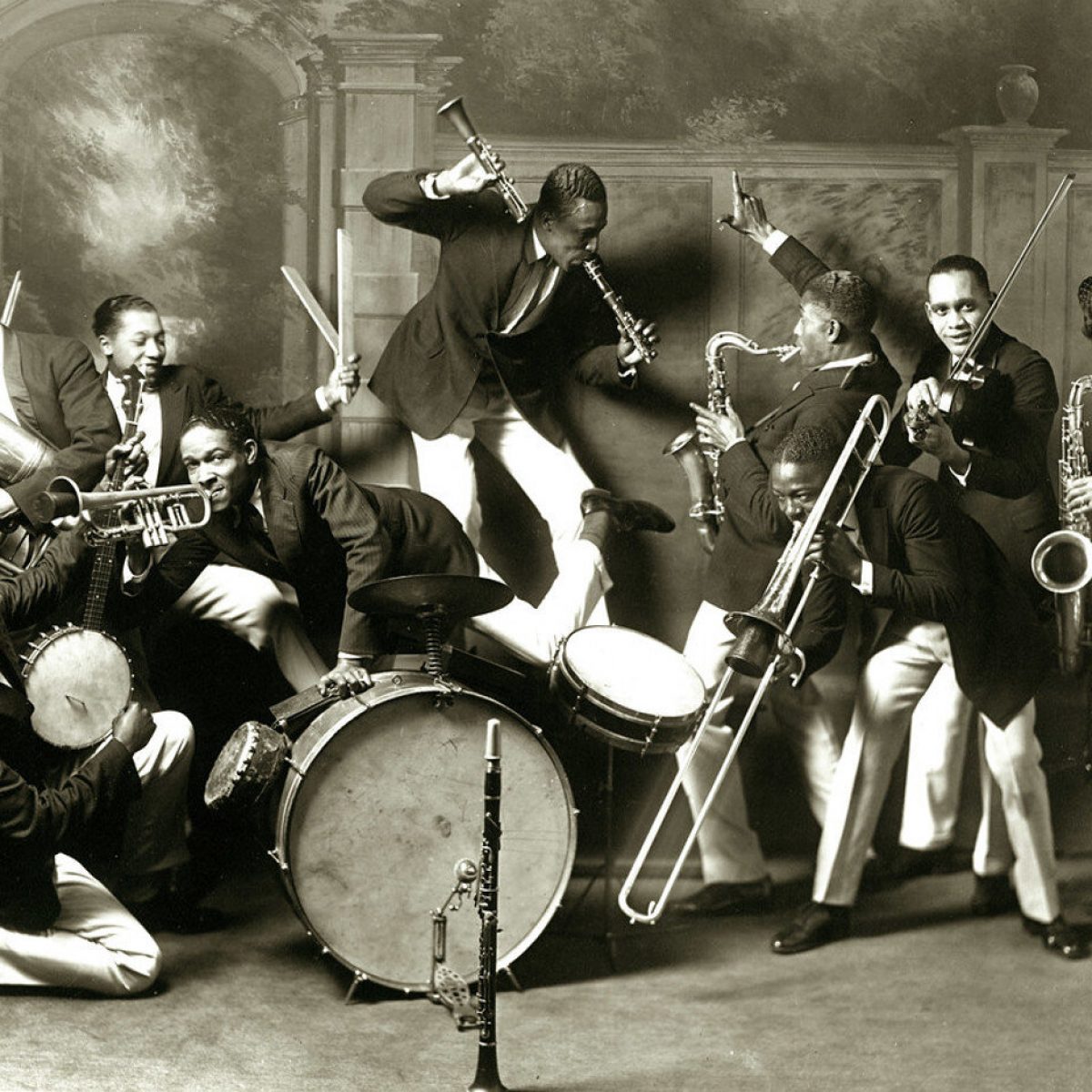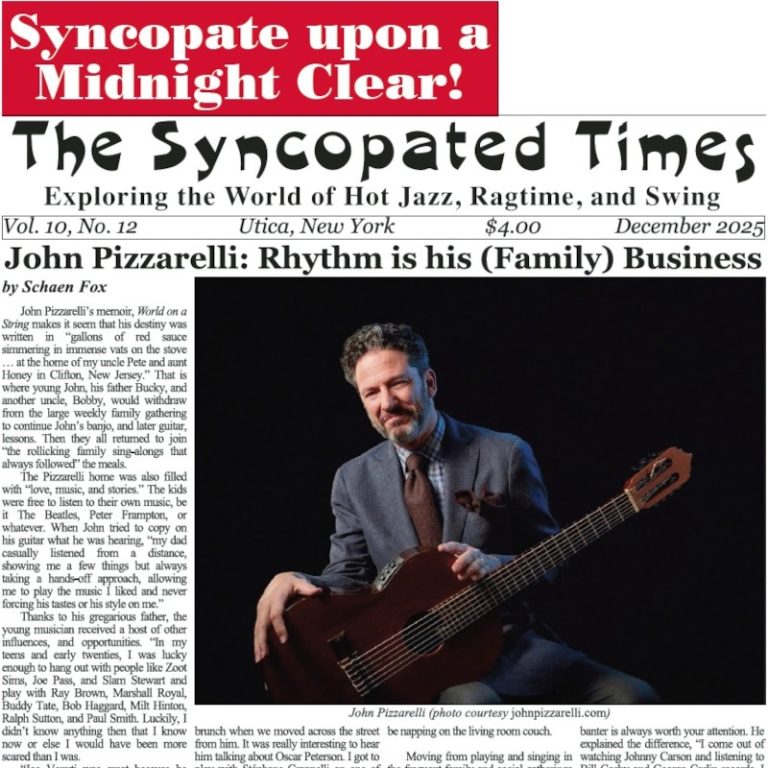 Jimmy Yancey (February 20, 1894, 1895,or 1901 – September 17, 1951) was a native of Chicago and learned to play piano from his elder brother, Alonzo, who was a Ragtime picker. Yancey’s father was a buck and wing dancer, and the kids were part of the act; sometime before 1915, the Yanceys appeared at Buckingham Palace before English Royalty. During the First World War, Jimmy Yancey played baseball in a Negro league team, the Chicago All-Americans.
Jimmy Yancey (February 20, 1894, 1895,or 1901 – September 17, 1951) was a native of Chicago and learned to play piano from his elder brother, Alonzo, who was a Ragtime picker. Yancey’s father was a buck and wing dancer, and the kids were part of the act; sometime before 1915, the Yanceys appeared at Buckingham Palace before English Royalty. During the First World War, Jimmy Yancey played baseball in a Negro league team, the Chicago All-Americans.
It is widely stated that Yancey “invented” boogie-woogie; not possible given its rural mid-western roots, and that traces of this style appear in sources which lead back to the late 1870s. However, inasmuch as Chicago style of boogie-woogie is concerned, Yancey is known to have been playing such music in Chicago prior to 1920. In the early 1920s, Jimmy Yancey was a regularly seen player on the rent party circuit in Chicago, and under his spell a number of boogie pianists emerged, including Meade “Lux” Lewis, Albert Ammons and, probably, Clarence “Pinetop” Smith. In 1925, Yancey got a full time job as the groundskeeper of Comiskey Park in Chicago, and afterwards cut back on his rent party appearances.
In 1936, Meade “Lux” Lewis first recorded his piece Yancey Special, a boogie-woogie solo in part based on Yancey’s economic style of playing. Not long after, record producers and critics began to inquire just who Yancey was. In April of 1939, Jimmy Yancey finally, at age 41, was able to enter the studio for his maiden voyage on record for a short-lived label named Solo Art. Swiftly making up for the time he had lost, Yancey recorded 17 pieces in 18 sides at this first session. Only the first two made it to 78s, and the rest did not appear until after Yancey’s death. However, this got things rolling for Yancey, and later that year he recorded the first of two sessions for Bluebird.
The following year Yancey recorded for both Bluebird and Vocalion. While critics, who cited the purity and originality of Yancey’s approach to boogie woogie, acclaimed his discs, they did not sell well and this chapter of Yancey’s recorded work ended after just 15 titles. Yancey returned to the studio just three times more in the decade left to him. The tiny Sessions label of Chicago recorded another 16 titles with Yancey in 1943, and these featured for the first time, Jimmy’s wife, Estella “Mama” Yancey on vocals. They had been married in 1917 and often made music together at home, Mama having a beautifully soulful blues voice that matched perfectly with Jimmy’s pianism.
Only three sides in Yancey’s recorded output bear Jimmy’s own vocals, and these confirm that the task of vocalizing on Jimmy’s records was best left to Mama Yancey. There was nothing more from Yancey until December 1950 when John Steiner recorded him in six sides for the resuscitated Paramount label. Jimmy Yancey’s final session was made for fledgling indie Atlantic Records and spread over two days in July 1951, producing, as in his first session, 17 masters. He was joined by Mama Yancey on five of these. Two months later Jimmy Yancey died of a diabetic stroke, only 53 years of age. Mama Yancey continued to record for Atlantic, and other labels, long after Jimmy Yancey died.
Much has been written about Yancey’s influence on younger boogie pianists from south side, but little of this writing has much to say about how different he was from the players who claimed his influence. Yancey almost never uses walking bass patterns or octaves. He preferred a falling triad figure in fast pieces, and a slowly wandering variant of that same figure in slower ones. His right hand was endlessly exploratory, always going to new and unexpected places. Yancey’s chops are obviously somewhat limited and he never shows off in the way that Lux or Pete Johnson could.
Nevertheless, the ingeniousness of Yancey’s playing is in its unpredictability and the way he makes his sometimes-eccentric ideas make sense. Yancey had a famous stylistic quirk– at the end of every piece he would always turn back to the same tag in E-flat, without regard for what he was doing before leading up to that. The theoretical and formal implications of Yancey’s work are so interesting that it motivated Dutch minimalist composer Louis Andriessen to compose a piece for wind ensemble entitled “On Jimmy Yancey” (1973). Yancey seldom repeated pieces, apart from vocal numbers, and is not known to have gone beyond two takes in making any of his studio recordings.
On January 23, 1986, Jimmy Yancey was inducted into the Rock and Roll Hall of fame, largely based on his contributions to the development of Boogie Woogie as a style. Mama Yancey was present at this ceremony, although she would die mere months later. Fortunately, in terms of being to experience Jimmy Yancey we are not just limited to his studio recordings. While there are no radio broadcasts of his playing extant, home recordings of Yancey family music making exist in two batches, one consisting of instantaneous-cut lacquers made in 1943, the other being wire recordings made in 1951. The sound quality of these recordings is extremely variable, but they offer a casual, candid glimpse into the inner world of Jimmy Yancey’s music making. Despite the influence he may have had on boogie-woogie, which dominated the popular music scene in the late 1930s and early 1940s, Jimmy Yancey’s own music was made for fun, enjoyment and relaxation-the commercial music world is damned. —By Dave Lewis
| Title | Recording Date | Recording Location | Company |
| Bear Trap Blues (Jimmy Yancey) |
2-23-1940 | Chicago, Illinois | Vocalion 05490 |
| Beezum Blues (Jimmy Yancey) |
4-1939 | Chicago, Illinois | Solo Art unissued |
| Big Bear Train (Jimmy Yancey) |
4-1939 | Chicago, Illinois | Solo Art unissued |
| Boodlin’ (Jimmy Yancey) |
12-1943 | Chicago, Illinois | Session 10-001 |
| Crying In My Sleep | 9-6-1940 | Chicago, Illinois | Bluebird B-8630 |
| Death Letter Blues | 9-6-1940 | Chicago, Illinois | Bluebird B-8630 |
| Five O’Clock Blues (Jimmy Yancey) |
10-25-1939 | Chicago, Illinois | Victor 26590-A |
| Janie’s Joys (Jimmy Yancey) |
4-1939 | Chicago, Illinois | Solo Art unissued |
| Jimmy’s Stuff (Jimmy Yancey) |
4-1939 | Chicago, Illinois | Solo Art 12008 |
| Jimmy’s Rocks (Jimmy Yancey) |
12-1943 | Chicago, Illinois | Session 10-001 |
| How Long Blues (Jimmy Yancey) |
4-1939 | Chicago, Illinois | Solo Art unissued |
| How Long Blues No. 2 (Jimmy Yancey) |
4-1939 | Chicago, Illinois | Solo Art unissued |
| I Love To Hear My Baby Call My Name (Jimmy Yancey) |
9-3-1940 | Chicago, Illinois | Gannet 5138 |
| Lean Bacon (Jimmy Yancey) |
4-1939 | Chicago, Illinois | Solo Art unissued |
| LaSalle Street Breakdown (Jimmy Yancey) |
4-1939 | Chicago, Illinois | Solo Art unissued |
| Lucille’s Lament (Jimmy Yancey) |
4-1939 | Chicago, Illinois | Solo Art unissued |
| Old Quaker Blues (Jimmy Yancey) |
2-23-1940 | Chicago, Illinois | Vocalion 05490 |
| P.L.K Special (Jimmy Yancey) |
4-1939 | Chicago, Illinois | Solo Art unissued |
| Rolling The Stone (Jimmy Yancey) |
4-1939 | Chicago, Illinois | Solo Art unissued |
| Slow And Easy Blues (Jimmy Yancey) |
10-25-1939 | Chicago, Illinois | Victor 26591-B |
| South Side Stuff (Jimmy Yancey) |
4-1939 | Chicago, Illinois | Solo Art unissued |
| State Street Special (Jimmy Yancey) |
10-25-1939 | Chicago, Illinois | Victor 26589-A |
| Steady Rock Blues (Jimmy Yancey) |
4-1939 | Chicago, Illinois | Solo Art unissued |
| Tell ‘Em About Me (Jimmy Yancey) |
10-25-1939 | Chicago, Illinois | Victor 26590-B |
| The Mellow Blues (Jimmy Yancey) |
10-25-1939 | Chicago, Illinois | Victor 26591-A |
| 35th And Dearborn (Jimmy Yancey) |
9-3-1940 | Chicago, Illinois | Gannet 5138 |
| 35th And Dearborn (Jimmy Yancey) |
9-6-1940 | Chicago, Illinois | Victor 27238-B 053439-1 |
| 35th And Dearborn (Jimmy Yancey) |
9-6-1940 | Chicago, Illinois | RCA X EVAB 3000 053439-2 |
| Two O’Clock Blues (Jimmy Yancey) |
4-1939 | Chicago, Illinois | Solo Art unissued |
| The Fives (Jimmy Yancey) |
4-1939 | Chicago, Illinois | Solo Art 12008 |
| Yancey’s Bugle Call (Jimmy Yancey) |
9-6-1940 | Chicago, Illinois | Victor 27238-A 053438-1 |
| Yancey’s Bugle Call (Jimmy Yancey) |
9-6-1940 | Chicago, Illinois | RCA X EVAB 3000 053438-2 |
| Yancy Getaway (Jimmy Yancey) |
4-1939 | Chicago, Illinois | Solo Art unissued |
| Yancy Limited (Jimmy Yancey) |
4-1939 | Chicago, Illinois | Solo Art unissued |
| Yancey’s Mixture (Jimmy Yancey) |
12-1943 | Chicago, Illinois | Session unissued |
| Yancy Stomp (Jimmy Yancey) |
10-25-1939 | Chicago, Illinois | Victor 26589-B |
Redhotjazz.com was a pioneering website during the "Information wants to be Free" era of the 1990s. In that spirit we are recovering the lost data from the now defunct site and sharing it with you.
Most of the music in the archive is in the form of MP3s hosted on Archive.org or the French servers of Jazz-on-line.com where this music is all in the public domain.
Files unavailable from those sources we host ourselves. They were made from original 78 RPM records in the hands of private collectors in the 1990s who contributed to the original redhotjazz.com. They were hosted as .ra files originally and we have converted them into the more modern MP3 format. They are of inferior quality to what is available commercially and are intended for reference purposes only. In some cases a Real Audio (.ra) file from Archive.org will download. Don't be scared! Those files will play in many music programs, but not Windows Media Player.






